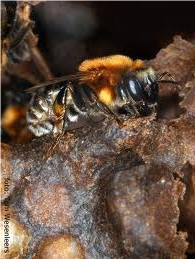Melipona subnitida
| Melipona subnitida | |
|---|---|
 |
|
| Scientific classification | |
| Kingdom: | Animalia |
| Phylum: | Euarthropoda |
| Class: | Insecta |
| Order: | Hymenoptera |
| Family: | Apidae |
| Genus: | Melipona |
| Species: | M. subnitida |
| Binomial name | |
|
Melipona subnitida Ducke, 1911 |
|
Melipona subnitida is a neotropical endemic bee species in the Apidae family found in the dry areas of Northeastern Brazil. This species of stingless bees practices single mating, monogynous habits.
This species nests in hollow trunks of living trees, where the workers create a vertical colony. The dominance hierarchy of these perennial colonies is defined by one queen who controls her workers. Out of all of the stingless bees, M. subnitida is fairly profitable given its ability to pollinate and create honey. The field research on this species is part of the ongoing subject of Behavioral Ecology.
Melipona subnitida is part of the family Apidae. This species is within the tribe Meliponini ("stingless bees"), and was originally described by Adolpho Ducke, a Brazilian researcher.
The Melipona subnitida species is divided into the queen, female workers, and males within each colony. They are identifiable by their obscure metasomal bands, lack of facial maculation, and fulvous thoracic pile.
The queen of the Melipona subnitida typically only mates with one male, resulting in high relatedness between female offspring of 0.75 since males are haploid so sisters are 100% related through the male line and half related through the female. The queen lays eggs and lives with her daughters, who are expected to stay with her and help her to maintain the young. The queen is identifiable by her lack of pollen carrying hairs on certain legs and she is smaller in size. Also, her abdomen becomes highly expanded, to a point it can no longer fly.
The workers of this species maintain the strongest fighting abilities, and come from larger cells than males.
The males of Melipona subnitida are reared similarly to workers, although they are raised in different cell sizes. Workers of M. subnitida strongly resemble those of Melipona favosa.
Melipona subnitida are commonly found in Northeastern Brazil where they are thought to be a main contributor of pollen and honey production. They are found specifically in the hollow trunks of living Bursera leptophloeos trees. Additionally, they have been noted in the Caatinga biomes, where the human population is reliant on their pollination and honey production for economic growth.
...
Wikipedia
